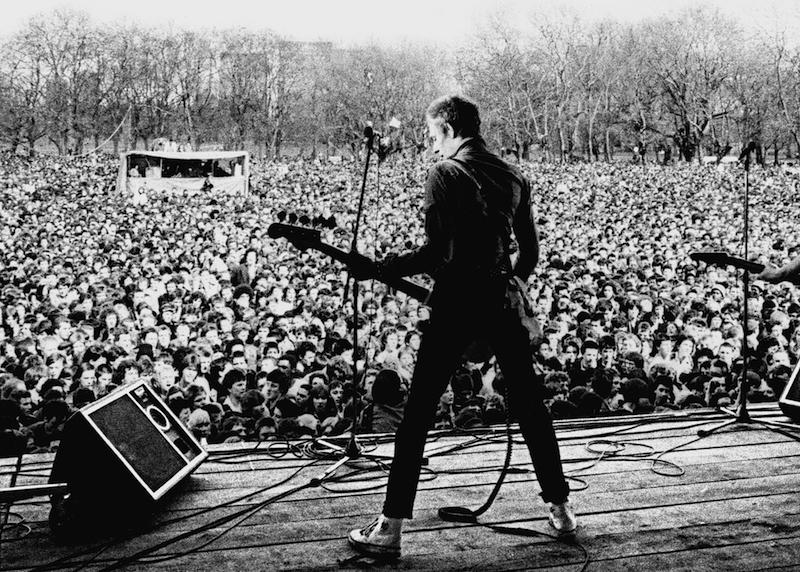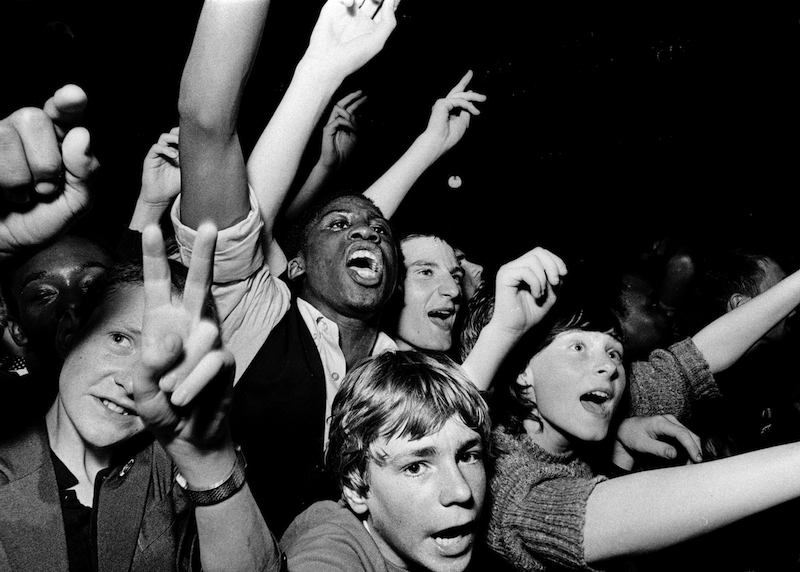White Riot review - energetic documentary races through the history of Rock Against Racism | reviews, news & interviews
White Riot review - energetic documentary races through the history of Rock Against Racism
White Riot review - energetic documentary races through the history of Rock Against Racism
The power of music to change hearts and minds in the 1970s

This documentary about the 1970s activist movement Rock Against Racism comes with festival prizes and much acclaim.
The filmmakers behind White Riot doubtless intend not only to celebrate the surviving veterans of a heroic movement, but also to encourage the current generation faced with resurgent racism. Director/editor Rubika Shah pays heartfelt homage to the now greying radicals who, as young activists, put together radical fanzines exhorting awareness of racism as well as nationwide concerts where black and white musicians shared the stage to seduce young fans away from the neo-Nazis’ siren calls.
In the mid-70s, National Front leader Martin Webster was inflaming racial tensions in cities across the UK, exhorting followers that their beloved nation was at risk of becoming "occupied by a load of khaki-coloured multiracial bastards". Rock stars like Eric Clapton and Rod Stewart were spouting anti-immigrant slogans and even David Bowie (briefly) found fascism fascinating. Some iconoclastic young performers were attracted to Nazi imagery (Siouxsie, Sid Vicious, Adam Ant) and it looked for a while as if punk could go the same way.
Instead, an assortment of left-wingers experienced in agit prop theatre and the counter culture, started to put on gigs with the express aim of countering the neo-Nazi movement. Bands like the Gang of Four, the Clash, X-Ray Spex, Steel Pulse and Matumbi would play on the same stage, pumping out a message that racism was not cool. Jimmy Pursey, lead singer of Sham '69 had a huge skinhead following but joined the Clash to perform the anti-racist anthem, White Riot. Between '76 and '82, local RAR groups sprung up around the country and put on gigs to push the idea that one could love rock and hate racism. Activism wasn't confined to countering racial prejudice but also tackling gay and women's rights too.
Shah's documentary zips through the complex history of Rock Against Racism and its collaboration with the Anti-Nazi League without the aid of commentary. Instead she uses archive (not always captioned, so picking out what’s documentary, what’s TV and what’s actually a feature film is difficult) and faux-fanzine style graphic sequences signpost key events to craft an uplifting tale.
Interviews with veteran counter-culture artists like founders David ‘Red’ Saunders and Syd Shelton, and with musicians like Dennis Bovell, Pauline Black and Topper Headon are intercut with heady footage of the glory days of Rock Against Racism. As well as the music performances, we get a scene-setting whistle stop tour of everyday prejudice on British TV with a montage from sitcoms like It Ain’t Half Hot Mum and Love thy Neighbour.  The history of Rock Against Racism is complex, there were personal and political factions and divided loyalties; RAR’s relationship to the Socialist Workers Party is also somewhat glossed over. For a more nuanced history, it's worth tracking down David Widgery's memoir, Beating Time. While it’s glorious to see the performances and remember the idealistic energy of RAR, it’s perhaps a little too much to imply in a final caption that RAR was victorious in ’79 when the National Front failed to win seats in the General Election. We got Margaret Thatcher’s government, which introduced the punitive anti-immigration legislation which has racked Britain ever since.
The history of Rock Against Racism is complex, there were personal and political factions and divided loyalties; RAR’s relationship to the Socialist Workers Party is also somewhat glossed over. For a more nuanced history, it's worth tracking down David Widgery's memoir, Beating Time. While it’s glorious to see the performances and remember the idealistic energy of RAR, it’s perhaps a little too much to imply in a final caption that RAR was victorious in ’79 when the National Front failed to win seats in the General Election. We got Margaret Thatcher’s government, which introduced the punitive anti-immigration legislation which has racked Britain ever since.
rating
Explore topics
Share this article
Add comment
The future of Arts Journalism
You can stop theartsdesk.com closing!
We urgently need financing to survive. Our fundraising drive has thus far raised £49,000 but we need to reach £100,000 or we will be forced to close. Please contribute here: https://gofund.me/c3f6033d
And if you can forward this information to anyone who might assist, we’d be grateful.

Subscribe to theartsdesk.com
Thank you for continuing to read our work on theartsdesk.com. For unlimited access to every article in its entirety, including our archive of more than 15,000 pieces, we're asking for £5 per month or £40 per year. We feel it's a very good deal, and hope you do too.
To take a subscription now simply click here.
And if you're looking for that extra gift for a friend or family member, why not treat them to a theartsdesk.com gift subscription?
more Film
 Bugonia review - Yorgos Lanthimos on aliens, bees and conspiracy theories
Emma Stone and Jesse Plemons excel in a marvellously deranged black comedy
Bugonia review - Yorgos Lanthimos on aliens, bees and conspiracy theories
Emma Stone and Jesse Plemons excel in a marvellously deranged black comedy
 theartsdesk Q&A: director Kelly Reichardt on 'The Mastermind' and reliving the 1970s
The independent filmmaker discusses her intimate heist movie
theartsdesk Q&A: director Kelly Reichardt on 'The Mastermind' and reliving the 1970s
The independent filmmaker discusses her intimate heist movie
 Blu-ray: Wendy and Lucy
Down-and-out in rural Oregon: Kelly Reichardt's third feature packs a huge punch
Blu-ray: Wendy and Lucy
Down-and-out in rural Oregon: Kelly Reichardt's third feature packs a huge punch
 The Mastermind review - another slim but nourishing slice of Americana from Kelly Reichardt
Josh O'Connor is perfect casting as a cocky middle-class American adrift in the 1970s
The Mastermind review - another slim but nourishing slice of Americana from Kelly Reichardt
Josh O'Connor is perfect casting as a cocky middle-class American adrift in the 1970s
 Springsteen: Deliver Me From Nowhere review - the story of the Boss who isn't boss of his own head
A brooding trip on the Bruce Springsteen highway of hard knocks
Springsteen: Deliver Me From Nowhere review - the story of the Boss who isn't boss of his own head
A brooding trip on the Bruce Springsteen highway of hard knocks
 The Perfect Neighbor, Netflix review - Florida found-footage documentary is a harrowing watch
Sundance winner chronicles a death that should have been prevented
The Perfect Neighbor, Netflix review - Florida found-footage documentary is a harrowing watch
Sundance winner chronicles a death that should have been prevented
 Blu-ray: Le Quai des Brumes
Love twinkles in the gloom of Marcel Carné’s fogbound French poetic realist classic
Blu-ray: Le Quai des Brumes
Love twinkles in the gloom of Marcel Carné’s fogbound French poetic realist classic
 Frankenstein review - the Prometheus of the charnel house
Guillermo del Toro is fitfully inspired, but often lost in long-held ambitions
Frankenstein review - the Prometheus of the charnel house
Guillermo del Toro is fitfully inspired, but often lost in long-held ambitions
 London Film Festival 2025 - a Korean masterclass in black comedy and a Camus classic effectively realised
New films from Park Chan-wook, Gianfranco Rosi, François Ozon, Ildikó Enyedi and more
London Film Festival 2025 - a Korean masterclass in black comedy and a Camus classic effectively realised
New films from Park Chan-wook, Gianfranco Rosi, François Ozon, Ildikó Enyedi and more
 After the Hunt review - muddled #MeToo provocation
Julia Roberts excels despite misfiring drama
After the Hunt review - muddled #MeToo provocation
Julia Roberts excels despite misfiring drama
 London Film Festival 2025 - Bradley Cooper channels John Bishop, the Boss goes to Nebraska, and a French pandemic
... not to mention Kristen Stewart's directing debut and a punchy prison drama
London Film Festival 2025 - Bradley Cooper channels John Bishop, the Boss goes to Nebraska, and a French pandemic
... not to mention Kristen Stewart's directing debut and a punchy prison drama
 Ballad of a Small Player review - Colin Farrell's all in as a gambler down on his luck
Conclave director Edward Berger swaps the Vatican for Asia's sin city
Ballad of a Small Player review - Colin Farrell's all in as a gambler down on his luck
Conclave director Edward Berger swaps the Vatican for Asia's sin city

Comments
Can I just take this